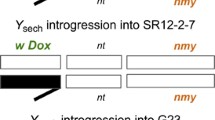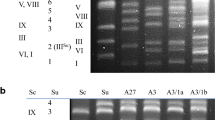Abstract
Interspecific crosses between D. melanogaster and D. simulans or its sibling species result in unisexual inviability of the hybrids. Mostly, crosses of D. melanogaster females X D. simulans males produce hybrid females. On the other hand, only hybrid males are viable in the reciprocal crosses. A classical question is the cause of the unisexual hybrid inviability on the chromosomal level. Is it due to the absence of a D. simulans X chromosome or is it due to the presence of a D. simulans Y chromosome? A lack of adequate chromosomal rearrangements available in D. simulans has made it difficult to answer this question. However, it has been assumed that the lethality results from the absence of the D. simulans X rather than the presence of the D. simulans Y. Recently I synthesized the first D. simulans compound-XY chromosome that consists of almost the entire X and Y chromosomes. Males carrying the compound-XY and no free Y chromosome are fertile. By utilizing the compound-XY chromosome, the viability of hybrids with various constitutions of cytoplasm and sex chromosomes has been examined. The results consistently demonstrate that the absence of a D. simulans X chromosome in hybrid genome, and not the presence of the Y chromosome, is a determinant of the hybrid inviability.
Similar content being viewed by others
References
Ashburner, M., 1989. Drosophila — A Laboratory Handbook. Cold Spring Harbor Laboratory, Cold Spring Harbor, N.Y.
Baker, W. K., 1971. Evidence for position-effect suppression of the ribosomal RNA cistrons in Drosophila melanogaster. Proc. Natl. Acad. Sci. USA 68: 2472–2476.
David, J. R., F.Lemeunier, L.Tsacas & C.Bocquet, 1974. Hybridation d'une nouvelle espèce, Drosophila mauritiana avec Drosophila melanogaster et D. simulans. Ann. Génét. 17: 235–241.
Durica, D. S. & H. M.Krider, 1977. Studies on the ribosomal RNA cistrons in interspecific Drosophila hybrids. Dev. Biol. 59: 62–74.
Durica, D. S. & H. M.Krider, 1978. Studies on the ribosomal RNA cistrons in interspecific Drosophila hybrids. II. Heterochromatic regions mediating nucleolar dominance. Genetics 89: 37–64.
Hutter, P. & M.Ashburner, 1987. Genetic rescue of inviable hybrids between Drosophila melanogaster and its sibling species. Nature 327: 331–333.
Hutter, P., J.Roote & M.Ashburner, 1990. A genetic basis for the inviability of hybrids between sibling species of Drosophila. Genetics 124: 909–920.
Inoue, Y. H., T.Taira & M-T.Yamamoto, 1988. Genetics of an unstable white mutant in Drosophila simulans: Reversion, suppression and somatic instability. Genetics 119: 903–912.
Lachaise, D., J. R.David, F.Lemeunier, L.Tsacas & M.Ashburner, 1986. The reproductive relationships of Drosophila sechellia with D. mauritiana, D. simulans and D. melanogaster from the Afrotropical region. Evolution 40: 262–271.
Lee, W. H., 1978. Temperature sensitive viability of hybrid between Drosophila melanogaster and D. simulans. Jpn. J. Genet. 53: 339–344.
Lindsley, D. L. & E. H. Grell, 1968. Genetic variations of Drosophila melanogaster. Carnegie Inst. Wash. Publ. 627.
Lohe, A. & P. A.Roberts, 1990. An unusual Y chromosome of Drosophila simulans carrying amplified rDNA spacer without rRNA genes. Genetics 125: 399–406.
Morgan, T. H., 1929. Experiments with Drosophila. Carnegie Inst. Wash. Publ. 399: 201–222.
Muller, H. J. & G.Pontecorvo, 1940. Recombinants between Drosophila species the F1 hybrids of which are sterile. Nature 146: 199.
Pontecorvo, G., 1943. Viability interactions between chromosomes of Drosophila melanogaster and Drosophila simulans. J. Genet. 45: 51–66.
Sawamura, K., T. Taira & T. K. Watanabe, 1993. Hybrid lethal systems in the Drosophila melanogaster species complex. I. The maternal hybrid rescue (mhr) gene of D. simulans. Genetics in press.
Sawamura, K., M-T. Yamamoto & T. K. Watanabe, 1993. Hybrid lethal systems in the Drosophila melanogaster species complex. II. The zygotic hybrid rescue (Zhr) gene of D. melanogaster. Genetics in press.
Sawamura, K. & M-T. Yamamoto, 1993. Cytogenetical localization of Zygotic hybrid rescue gene (Zhr) of Drosophila melanogaster that rescues interspecific hybrids from embryonic lethality. Mol. Gen. Genet. in press.
Sturtevant, A. H., 1920. Genetic studies on Drosophila simulans. I. Introduction. Hybrids with Drosophila melanogaster. Genetics 5: 488–500.
Sturtevant, A. H., 1929. The genetics of Drosophila simulans. Carnegie Inst. Wash. Publ. 399: 1–62.
Takamura, T. & T. K.Watanabe, 1980. Further studies on the Lethal hybrid rescue (Lhr) gene of Drosophila simulans. Jpn. J. Genet. 55: 405–408.
Watanabe, T. K., 1979. A gene that rescues the lethal hybrids between Drosophila melanogaster and D. simulans. Jpn. J. Genet. 54: 325–331.
Yamamoto, M-T, A.Mitchelson, M.Tudor, K.O'Hare, J. A.Davies & G. L. G.Miklos, 1990. Molecular and cytogenetic analysis of the heterochromatin-euchromatin junction region of the Drosophila melanogaster X chromosome using cloned DNA sequences. Genetics 125: 821–832.
Author information
Authors and Affiliations
Rights and permissions
About this article
Cite this article
Yamamoto, MT. Inviability of hybrids between D. melanogaster and D. simulans results from the absence of simulans X not the presence of simulans Y chromosome. Genetica 87, 151–158 (1993). https://doi.org/10.1007/BF00240554
Received:
Accepted:
Issue Date:
DOI: https://doi.org/10.1007/BF00240554




